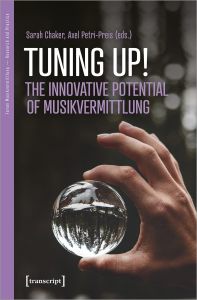Chaker, Sarah/Petri-Preis, Axel (eds.) (2022): Tuning up! The Innovative Potential of Musikvermittlung. Bielefeld: transcript verlag.
This publication, prepared by editors Sarah Chaker (IMS) and Axel Petri-Preis (IMP) on the basis of an mdw lecture series, offers a conglomerate of theory and practice pertaining to the innovative potential of those community and audience engagement-related artistic and educational practices that are known collectively as Musikvermittlung.

On 216 pages, Musikvermittlung is introduced not only as a professionalised occupation but also as a young research discipline that draws on expertise from the artistic realm, cultural management, music education, and sociology. Alongside a look into the field’s history and positioning, discussion is devoted to the increasing presence and necessity of this subject area, above all in German-language research (see, for instance, Under a Preservation Order? The Innovative Potential of Musikvermittlung to Renew Concert Life by Constanze Wimmer). This portrayal of the theoretical discourse is interwoven with examples from actual practice, and the introduced concert formats were all developed with both artistic and pedagogical aims in mind.
The employed approaches include measures to effect changes in terms of the setting (e.g. stage setup and seating, see Musikvermittlung as Everyday Practice. The Cello Quartet Die Kolophonistinnen by Sarah Chaker), preliminary and follow-up measures at concerts (e.g., moderation), and methods by which to nurture musical competencies and activate an audience (e.g., intensification of the listening process, participative composing projects). Special emphasis, however, is given to interventions in the social order (see Engaging with New Audiences. Perspectives of Professional Musicians’ Biographical Learning and Its Innovative Potential for Higher Music Education by Rineke Smilde). This entails not only appealing to target groups and age groups that lie outside the classical concert audience but also the deliberate mixing of audiences that would not normally encounter each other.
Another topic of reflection is that of the roles taken up by the various protagonists: music-makers, audiences, teachers, and researchers. In addition to their interrelationships, this is also about rethinking said roles: In what cases can musicians design their programmes and settings in ways that better involve their concert audiences? Where can the audience be active and make music instead of “just” listening passively (such as by way of response projects)? And last but not least, the field’s professionalisation via the establishment of university programmes is addressed.
This publication offers interested readers a well-founded overview of and look into the phenomenon of Musikvermittlung as well as suggestions for the design of their own concerts and engagement concepts. What’s more, Musikvermittlung is portrayed in-depth as a research topic, which makes this work a revealing read indeed for a diverse reading audience.

